Clayton Fredericks is what you call a ‘thinking rider’. He’s one of those competitors who is not only successful at the highest levels, but he is also able to communicate how he does it.
I caught up with him teaching a group of Victorian riders on ‘Fairhurst’, the beautiful Peninsula property of Sara Madden, whose 13-year-old daughter, Matilda was one of those benefitting from Clayton’s advice. Matilda is certainly a lucky girl with a home paddock full of professionally built cross-country jumps…
Clayton had worked with the riders the previous day on their flatwork, and he stressed that the cross-country session was just an extension of that:
“Yesterday we worked on stop/go, and that is what cross country is about. You need to have your horse more scared of the rider’s leg than any fence.”
The horses might need to be attentive to the leg aids, but at the same time the riders had to be tuned into the horses’ needs, and prepared to trust them:
“Lots of riders find it hard to let the reins go. They have their horses pulled into a short neck. What is important today is that I can give you the feeling of how you can let your horses be freer in the neck. The horse needs his head and neck to balance, interfere with his head and you interfere with his balance, and then the horse’s confidence goes out the window.”
“Cross-country training is all about confidence for the horse and the rider, I want you to leave today with more confidence – it is not about jumping the biggest jumps.”
“Cross-country riding is also about position. I showed you yesterday the exercise where you get your feet out of the stirrups and lift your knees and feel the balance. Riding is a core thing, and it is only when you find that balance that you can have your legs and hands working independently of your body.”
“It is also important not to be a nagging rider. A good old fashioned Pony Club-style kick can be much more effective at getting your horse to go forward than a stick, but you can only do it, if you have that balanced position.”
“The quickest way to ruin the horse’s confidence is to interfere with their balance. If you see that extra stride, or see an early take off, get into position and help keep the horse’s confidence.”
story continues after the addertisement
Another topic on the day’s agenda was turning, which as Clayton pointed out, is becoming increasingly important: “On the modern cross-country course there are lots of fences on turns, and it is important to turn effectively.”
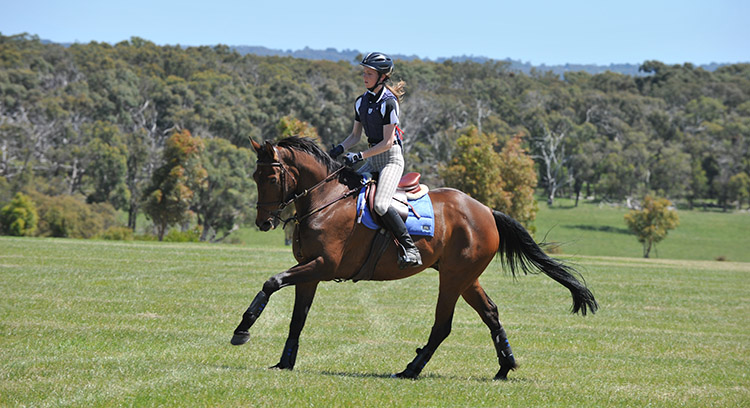
As preparation for the turn exercise, Clayton had the riders circle and imagine a little fence in front of them, and sit and ride the stride:
“When I was younger I used to pick a patch of grass: I’m going to put my horse’s front feet there. Practise, practise and you can do it.”
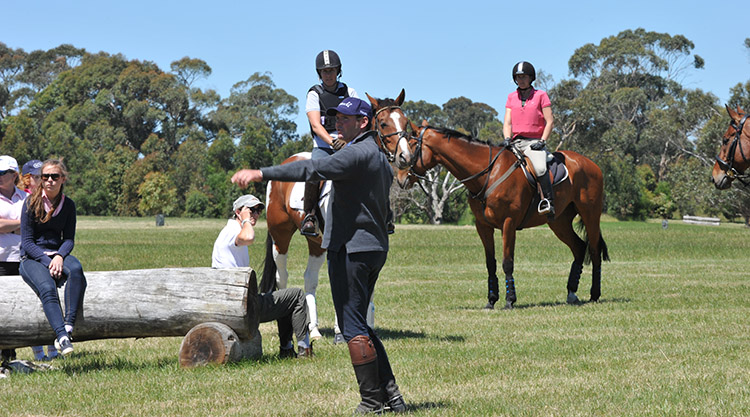
“The other vital thing in the turn is control of the horse’s shoulders. If you can control the shoulders, you can put them anywhere. The big mistake riders make is when they want a turn they pull on the inside rein, and pop out the shoulder. I want you to use a pirouette style turn. In dressage they call it a working pirouette, it is a training exercise. Open the inside rein, open your inside leg, close the outside rein, close the outside leg, and get the feeling of pirouette. Okay, it’s not a Grand Prix pirouette – but it’s not fast either.”
Of course, the home course with everything has just what Clayton needs – four big logs making a cross. The horse is to pop over one, do a working pirouette, pop over the next arm of the cross, and so on, around and around the four arms of the cross, repeating the clover leaf until the horse really gets back on its hocks, and is coming off the outside aids.
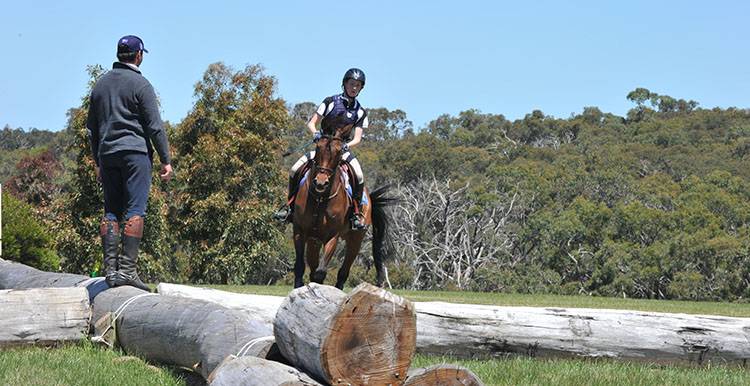
“Ride in, pop over, sit up, and while the horse is straight, into a working pirouette, balance the horse, and look where you are going. Your shoulders directly influence the horse’s shoulders, when you turn and look, that brings the horses shoulders in the right direction. As soon as you look, the horse starts to turn, but they won’t do it if you pull on the inside rein. You need a straight neck, and a straight horse, perhaps you have to put the whip in your outside hand. Sharon do the clover leaf until you feel the horse balancing underneath you.”
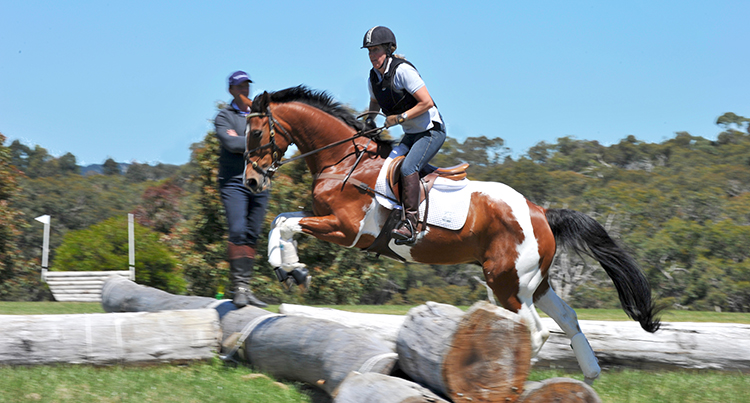
Now I have seen a horse in Portugal do a pirouette in counter canter with Rodrigo Torres, and for a moment there it looks as if Sharon Ridgway is about to repeat the feat with her Visage gelding, Puzzle.
Clayton isn’t fussed: “I’m not too worried about leads, the more you practice, the more the leads will come. This is an exercise like bounce poles, sometimes the horses pick it up faster than the riders.”
Apparently when Clayton demonstrated this exercise at Adelaide four star, he did it with the reins in one hand and a mike in the other on a horse he had never ridden before…
The next lesson was riding the dreaded skinny, read on below
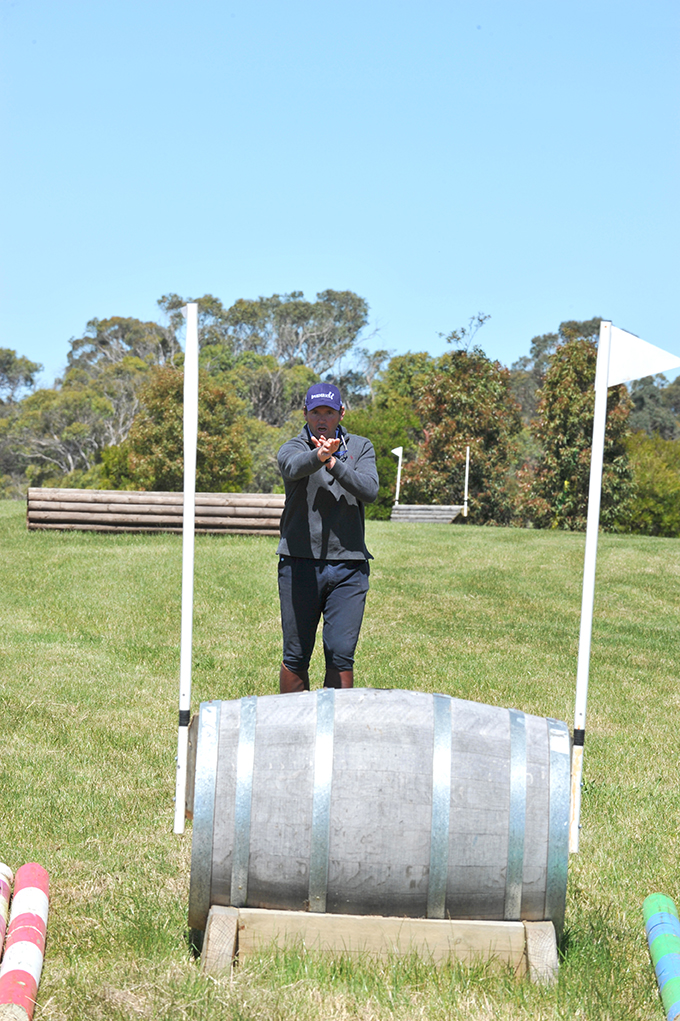
“Think about an arrow – it is only straight when it is travelling with acceleration. It is a bit the same with cross-country fences. Collect as you come to the fence, then the last few strides you accelerate forward.”
“The thing you don’t want to do is come to a skinny fence wrestling, not riding, pulling the horse backwards, and the horse is looking everywhere but the fence. You want to accelerate the last few strides and the horse has to have the freedom to look and work out the fence, the last thing he needs to be doing is worrying, oh she’s pulling on my head again. The horse is looking back at the rider, they stop thinking forward and run out. The more you give, the more the horse will relax – just get him on his line and let him go. Let him think about the fence.”
“No matter how good the horse is, you must have the feeling that three quarters of the horse is in front of you.”
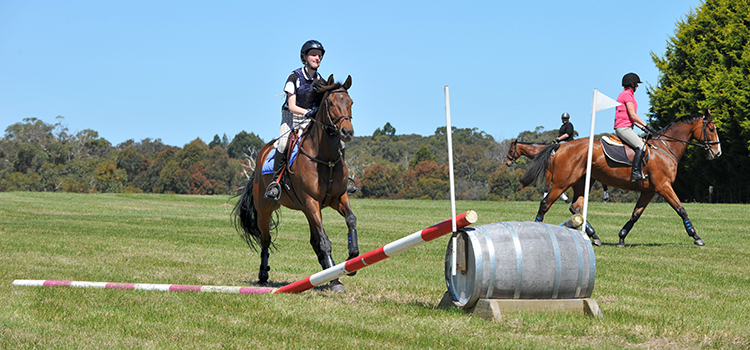
“For reasons of safety I want you to sit back at the fence, you have to be behind the horse. Your shoulders should be behind your hips at the fence, but in front of your hips between the fences. When you see a stride, don’t go forward with your body. Sit there, and get behind. Don’t be up on the horse’s neck or that is where you will go. How many riders fall off behind?”
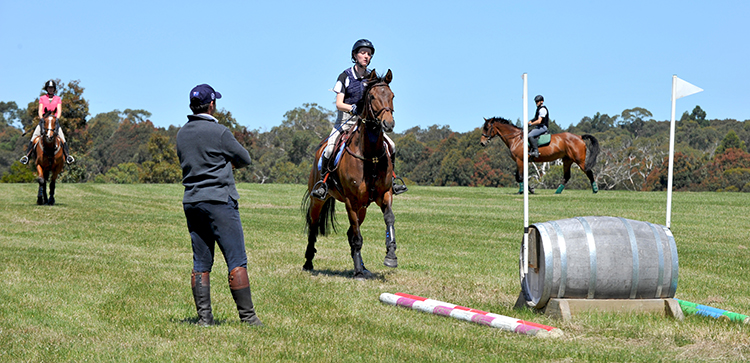
“Cross country is just about one question: is my horse in front of my leg?”
Clayton kept emphasising, let the horse think about the jumps:
“Train the horses to look to the jump. Learn the skill of presenting the horse – there’s where we want to go, and let it look and go there. Nine times out of ten, the horse will find its own legs, find its own stride. Just ride the horse through the trainer poles, don’t pull at the horse’s head, just ask, is he forward?”
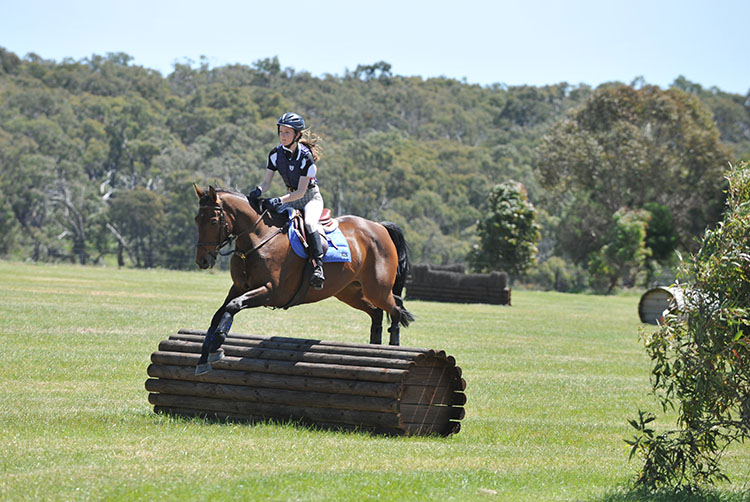
“Use the acceleration as the way to straightness. When they de-accelerate, they get wobbly.”
I’m not sure if Clayton was aware he was quoting the great German 19th-century riding master, Gustav Steinbrecht whose most famous maxim was: As the first main principle of the art I urge every rider to “ride your horse forward and set it straight!”
more cross country challenges follow
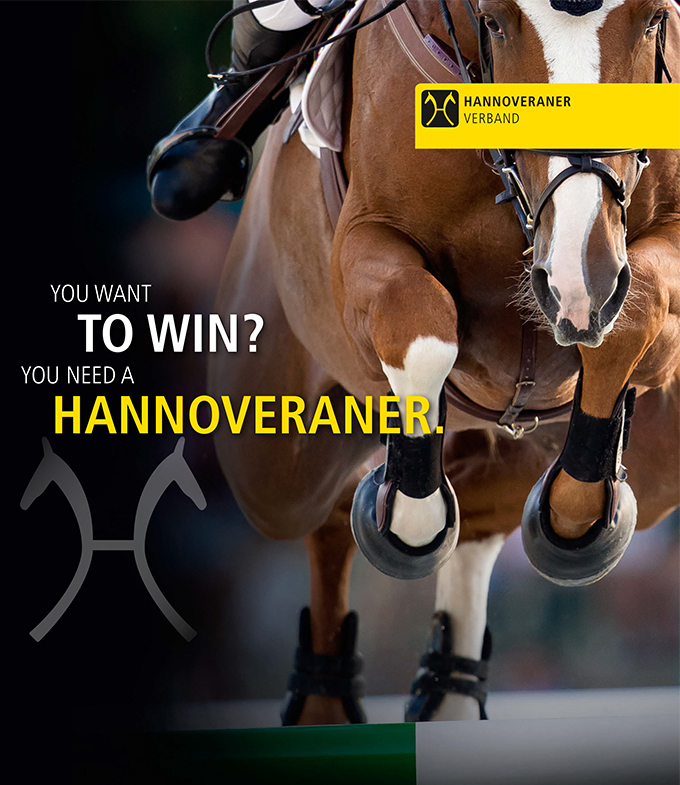
“Let the horses jump, don’t interfere with their mouths, then you will see the difference in their expression, their ears are pricked, they are focused and going. I’m not always going to say, get rid of the reins, but I had to today because you were interfering with your reins, and the horses weren’t looking at the jumps. At the competition still create that same feeling that you just present the horse and say, that’s where we are going. Sure if they go wobbly, you need to close your outside rein and leg, but not pulling the reins this way, then that way, do that and you have no chance.”
It was time to move to the beautifully constructed water jump. The riders were riding single file through the water as a starter…
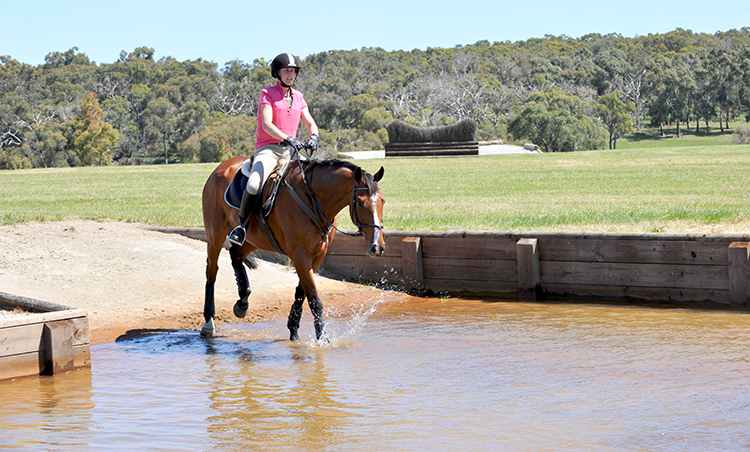
“Again this is a test of whether they are in front of your leg. Look ahead, go in, go in.”
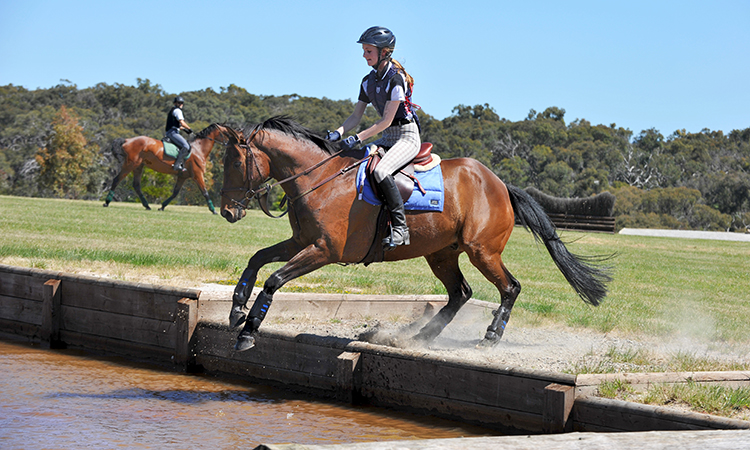
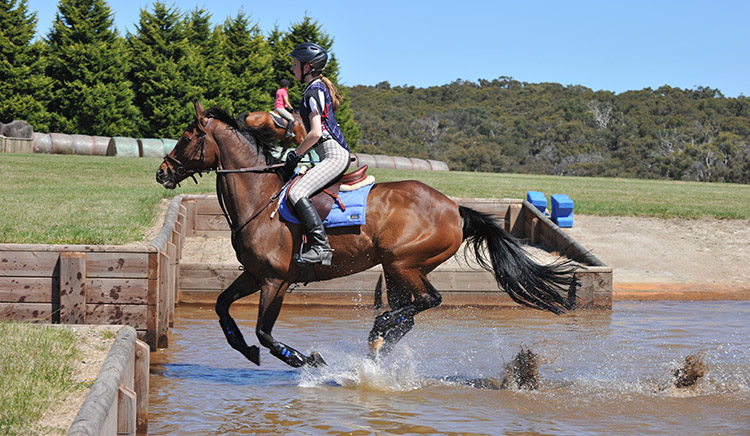
Once they had all got their feet wet, time for a little drop, and once again, Clayton wanted the riders in a defensive position:
“Don’t fold, don’t go forward with your body, sit behind, get your shoulders behind. Let the reins get longer, they need to use their head and neck to balance. When riders hold onto to the reins, that’s when they stop or cat-leap. You have to keep the horse straight and accelerating – but not crazy accelerating, you are riding to a drop. Don’t look down, look to the horizon, let the horse do the jumping. Drops are the one type of fence where I won’t tell you to look at the fence.”
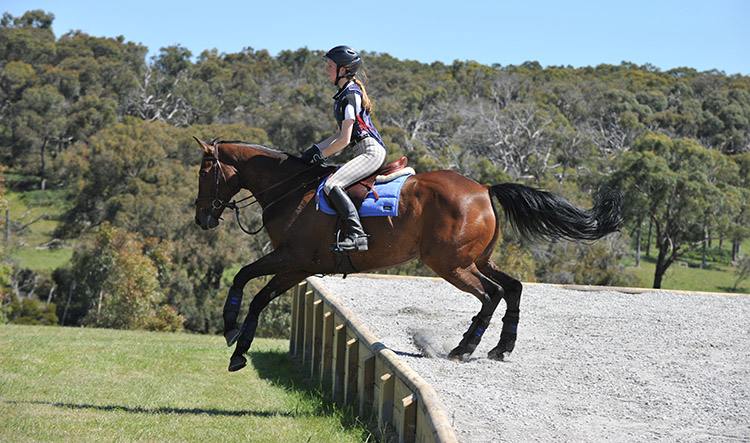
It was time to move on to the bank with a nice big drop, but Clayton was reassuring:
“All you’ve got to do is stay in the middle of your horse. Don’t look down, feel what’s going on, hold the reins at the buckle and experience the feel of the horse stretching, then it is so much easier for them. I’ve said it 100 times – look at the horizon, give the reins, don’t fold, leg on, leg on. It’s a brilliant fence because you guys have to take a deep breath and let go.”
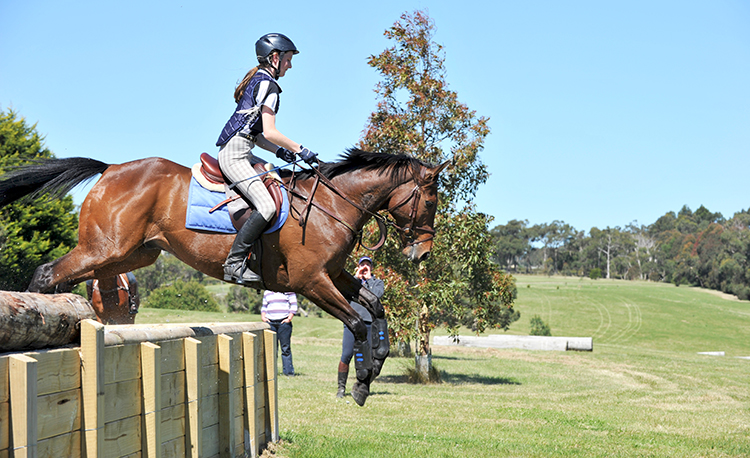
“These are good fences because only good riders can ride these fences. They had a few problems with these fences and the course builders stopped building them, I wish they hadn’t.”
next ditches
It was time for the last cross-country challenge of the day – the dreaded ditch.
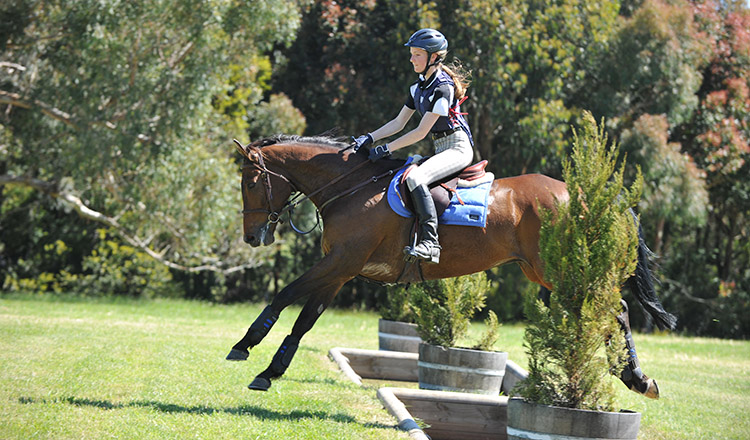
“It is the same question again – is the horse in front of your leg? Is the horse accelerating to the jump? And once again, let the horse’s head go so the horse can see where to leave the ground.”
At this point, Clayton asked Matilda to let him remove the noseband on Tainui Lad (Jimmie). “The theory is that when you connect the horse’s skull with its lower jaw, you interfere with the mechanics of the bit on the lower jaw. I find if you take away the noseband, the horse submits a lot easier. The noseband connects the jaw to the muscles of the neck and the horse finds it easier to go against you. The biggest myth in riding is the more they pull, the tighter you should make the noseband. Okay if the horse crosses its jaw, or something like that, you might need a noseband but most of the time, I find they go better without one.”
Certainly Matilda’s Jimmy was looking much more rideable without the noseband: “Before he was fighting the noseband, now when Matilda asks him to stop, he opens his mouth, but he stops.”
All the horses and riders handled the challenge of the ditch well, and Clayton was happy to call it a day:
“We said at the outset we wanted confident horses and confident riders, and I think we’ve got them.”






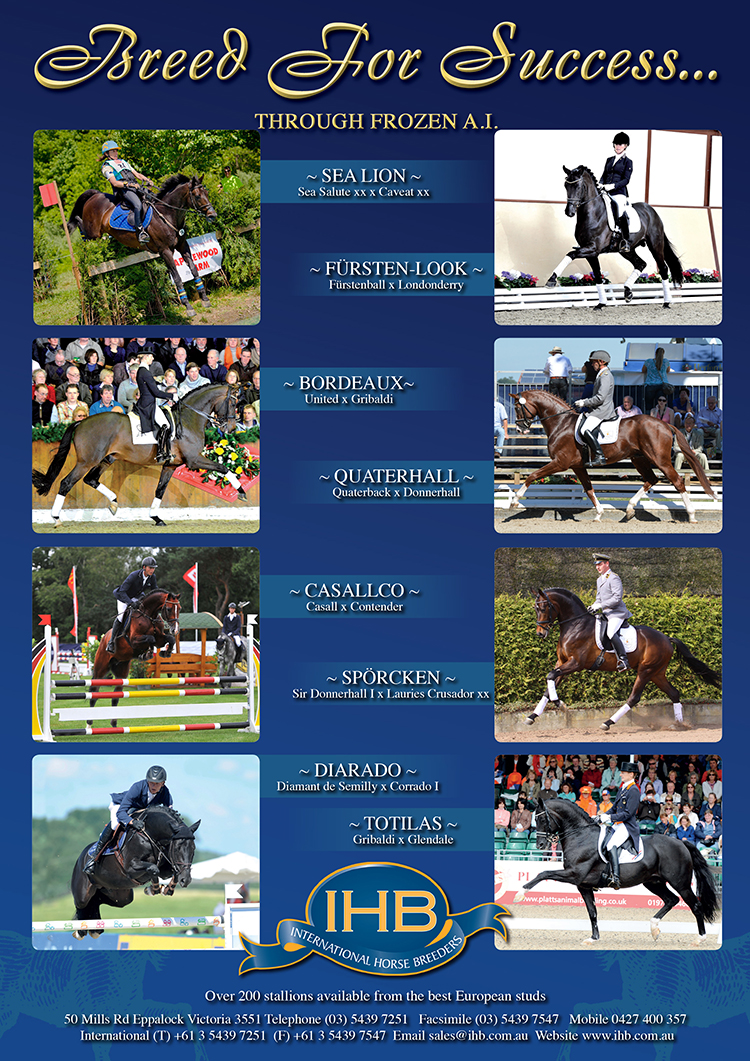
I have a really encouraging riding teacher but I’m still confused how to do. I guess I’ve learned from this experience, but do you have any other tips for getting more confident on cross-country? I used to be quite a nervous rider but have mostly conquered my nerves – it’s just at the cross-country that I need to grit my teeth and carry on with, but its really hard. Hope you can help.”
Great article and true reference the reins and Mike
Thanks Chris